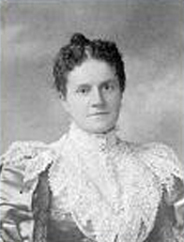 [Edit photo credit]
[Edit photo credit]1843 – 1903
"Some people's beauty lies not in the features, but in the varied expression that the countenance will assume under the various emotions. She is...a most entertaining talker, which is a mighty good thing you know, I myself being so stupid." — Washington Roebling on his wife Emily, in a letter to his sister, 1865. Emily Warren Roebling was born to an upper middle class family in Cold Spring, New York, the second youngest of 12 children. Wife, mother, lecturer, student, world traveler, and clubwoman, this multi-faceted Victorian woman was a pioneering example of independence. Despite advice in early years that women needed no higher education, she studied mathematics and science. And in 1899, at the age of 56, she obtained a law certificate from New York University.
In 1864, she traveled to see her brother, Gouverneur Warren, at an army camp where he was serving as commander of the Fifth Army Corps. During her visit she met a young officer named Washington Roebling, who immediately fell in love with her. After 11 months of constant correspondence, she and Roebling were married in 1865. After the war, she traveled with her husband to Europe on a mission to research technical issues related to a project his father, John A. Roebling, was planning: a bridge over New York's East River between Brooklyn and Manhattan. While overseas, she gave birth to a son, John A. Roebling II, who was born in the same town where Washington Roebling's father had been born, Muhlhausen, Germany. It was tragedy that drove Emily Roebling into the forefront of engineering.
Before construction of the Brooklyn Bridge could begin in earnest, her father-in-law died of tetanus. During the construction, her husband's health failed from decompression sickness contracted while working in the caissons for the bridge piers, deep beneath the river's surface. With Washington Roebling confined to his sickroom and fearing he wouldn't live to finish the project, she began taking down copious notes on what he said remained to be done. She also began studies of her own on the technical issues, learning about strength of materials, stress analysis, cable construction, and calculation of catenary curves. Every day, she went to the site to convey her husband's instructions to the workers and to answer questions. She kept records, answered the mail, and represented her husband at social functions. Eventually she became so good at this that many suspected she actually was the intelligence behind the bridge.
In spite of Washington Roebling's debilitating illness, the Roeblings continued to lead the project, thanks in part, at least, to Emily's persistence. When the Brooklyn Bridge opened in 1883, it was Emily Roebling who rode with President Chester Arthur across the great bridge. At the opening ceremony, a Roebling competitor, Abram Hewitt, said of her: "The name of Emily Warren Roebling will...be inseparably associated with all that is admirable in human nature and all that is wonderful in the constructive world of art." He called the bridge "an everlasting monument to the self-sacrificing devotion of a woman and of her capacity for that higher education from which she has been too long disbarred." After the bridge was completed, Emily Roebling moved to Trenton, New Jersey, with her husband and managed the construction of their mansion. She also assumed an active social life, taking on important roles in the Daughters of the American Revolution, the Huguenot Society, and other civic organizations. She traveled extensively, attending the coronation of Nicholas II in Russia, and was presented to Queen Victoria in London in 1896. She also served as both a nurse and construction foreman at Montauk, Long Island camp, established to house soldiers returning from the Spanish-American War.
In the abstract for her book, Silent Builder: Emily Warren Roebling and the Brooklyn Bridge , Marilyn Weigold states, "Emily Warren Roebling's career as a silent builder and organization (wo)man was terminated by death in 1903, but her achievements, not the least of which was the Brooklyn Bridge, have endured."
Resources: Logan, Mary S, The Part Taken by Women in American History , Arno Press, 1972; McCullough, David, The Great Bridge: The Epic Story of the Building of the Brooklyn Bridge, Simon & Schuster, 1983; Weigold, Marilyn, Silent Builder: Emily Warren Roebling and the Brooklyn Bridge , Associated Faculty Press, 1984.

